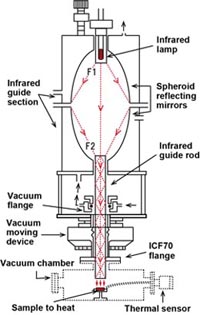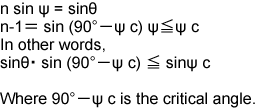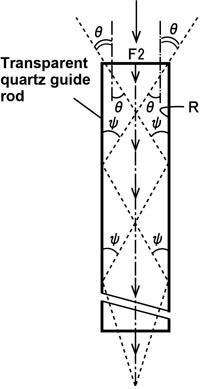Mechnism
Objects irradiated with infrared undergo a rise in temperature. Infrared radiation has the same properties as visible light (such as radiance, convergence, reflection, transmission and refraction), and infrared guide heating systems work by skillfully harnessing these properties. An infrared guide heating system consists primarily of an infrared lamp, spheroid reflecting mirror and transparent quartz guide rod. As shown in Figure 1, the infrared lamp heat source is mounted at the first focal point of the spheroid reflecting mirror (F1). When the lamp is turned on, the infrared emitted from it is reflected by the spheroid mirror and converges at the second focal point (F2). The guide rod is mounted at F2, and the converged infrared is guided into it. Some of the infrared is transmitted straight through the rod, and some of it undergoes repeated total reflection from the rod’s inner walls.

Total reflection type
As shown in Figure 2, when infrared radiation enters a transparent quartz guide rod with an incident angle of θ and a refraction angle of ψ in a rod having a refractive index of n, the total reflection condition for an incident angle of 90°-ψ on the rod’s inner wall surface R is given by:

Infrared radiation entering with an incident angle that satisfies the condition of formula above undergoes total reflection by the rod’s inner wall surface. It is transmitted by repeated total reflection without being emitted from the inner wall surface to the outside, until being emitted from the tip. A sample placed near the tip absorbs the infrared radiation and undergoes a temperature rise.
Conventionally, three basic modes of heat transfer have been recognized—conduction, convection, and radiation. Infrared radiation emitted from an infrared lamp and condensed by a spheroid mirror to convey heat by repeated total reflection within a rod is a completely new method of heat transfer that does not correspond to any of the three conventional modes. It is known as heat transfer by total reflection or multiple reflection.
Heating by this method of heat transfer enables the transfer of heat from the heat source to the heated object in a closed space with nearly no heat emitted outside, making it a very efficient method in terms of energy-saving.
Conventional resistance-driven electric furnaces and infrared heating furnaces raise the temperature of a sample when the sample is placed near the heat source in the furnace. In contrast, infrared guide heating systems convey infrared radiation from the heat source to near the sample, irradiating it and raising its temperature without it being moved.

